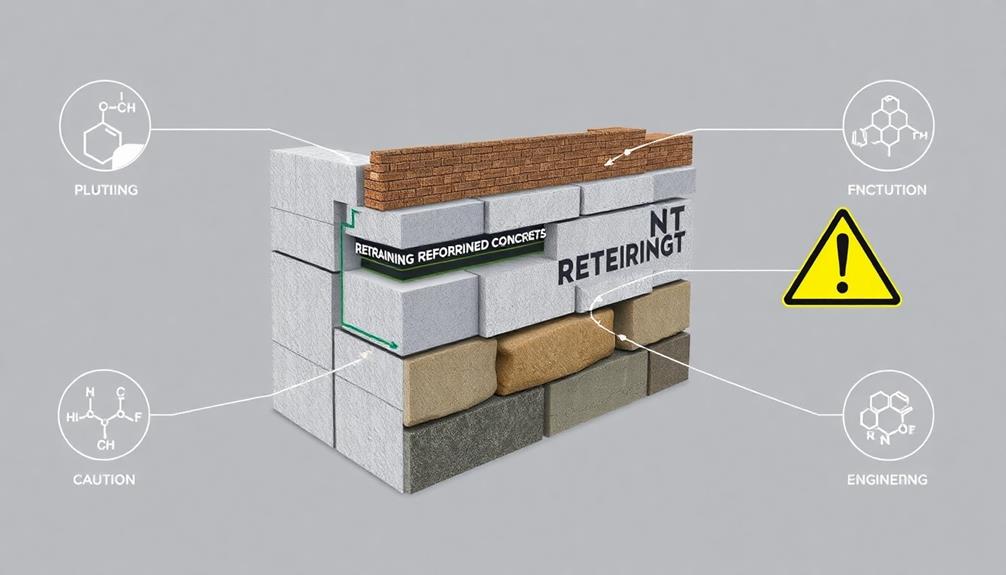Regulations in retaining wall design are imperative for ensuring structural integrity, protecting the environment, and enhancing public safety. They provide a framework to understand factors like soil properties, wall height, and load distribution, which are essential to prevent failures like sliding or collapsing. Environmental guidelines focus on preventing soil erosion and preserving ecosystems by using materials with lower carbon footprints and construction practices that mitigate environmental disturbances. Additionally, adherence to safety standards safeguards against hazards such as erosion or flooding, ensuring durable and reliable structures. Understanding these regulations leads to innovative strategies that support both environmental and structural objectives.
Table of Contents
ToggleWalls Contractor Highlights
- Regulations ensure retaining walls' structural integrity by addressing load distribution, hydrostatic pressure, and drainage, preventing sliding, overturning, or collapsing.
- Environmental regulations prevent soil erosion and water runoff, protecting ecosystems and aligning design with ecological preservation goals.
- Safety standards in retaining wall design optimize material selection, wall height, and load-bearing capacity for public safety.
- Cost efficiency is supported through regulations by promoting use of durable local materials, optimizing resource use, and implementing advanced design techniques.
- Material safety guidelines require rigorous testing to ensure compatibility, durability, and adherence to regulatory standards, fostering trust and community safety.
Purpose of Regulations

Retaining wall design regulations serve three primary purposes: guaranteeing structural integrity, protecting the environment, and enhancing public safety. These regulations mandate the use of appropriate materials, design practices, and construction techniques to maintain the stability and longevity of the walls, thereby preventing potential failures.
Custom design solutions are often required to verify compliance with local building codes while meeting specific site conditions. Additionally, they address environmental considerations by minimizing soil erosion and controlling water runoff, while also prioritizing the safety of both construction personnel and the general public through adherence to established safety standards.
Ensuring Structural Integrity
Structural integrity is a critical aspect of retaining wall design that underpins the very essence of safety and durability. Regulations play a pivotal role in guaranteeing that retaining walls are engineered to maintain stability under various loads and environmental conditions. These guidelines address factors such as soil properties, wall height, slope gradient, and material selection, which collectively influence the wall's ability to resist failure, such as sliding, overturning, or collapsing.
Regulations provide a framework that engineers and builders use to calculate proper load distribution, account for hydrostatic pressure, and determine appropriate drainage solutions. By adhering to these standards, professionals guarantee that retaining walls not only perform their intended function but also sustain long-term use without posing risks to communities.
The extensive nature of retaining wall regulations empowers those involved to craft solutions that stand up to external forces, such as wind or seismic activity, guaranteeing public safety. Moreover, collaboration and compliance help create a shared understanding that emphasizes trust and responsibility among designers, builders, and regulators. These established standards reflect a collective commitment to quality and resilience, underscoring the importance of stringent regulations in fostering confidence and security within built environments.
Protecting Environmental Impact
In retaining wall design, protecting the environmental impact is a critical consideration underpinning the purpose of regulations. These regulations guarantee that retaining walls are constructed in ways that preserve the ecological balance of surrounding landscapes and protect natural habitats. Such regulations are designed to prevent soil erosion and water runoff that can harm nearby ecosystems, carefully guiding construction to minimize disruption to native flora and fauna. This pivotal focus on environmental protection reflects a societal commitment to sustainable development, fostering a sense of collective responsibility among stakeholders involved in construction and design.
The implementation of these regulations requires a careful assessment of local environmental conditions to tailor design practices that align with ecological preservation goals. This includes choosing materials that reduce carbon footprint and utilizing construction methods that limit disturbances to the earth's natural processes. By adhering to these guidelines, builders contribute to long-term sustainability, maintaining harmony between human activity and nature. Additionally, these standards help to instill a shared vision of environmental stewardship within the community. By embracing regulations that prioritize ecological conservation, designers and builders not only protect their projects but also express a communal dedication towards safeguarding the planet for future generations.
Enhancing Public Safety
While safeguarding environmental protection remains paramount, the core intent of retaining wall design regulations also centers on enhancing public safety. As structural elements integral to landscapes vulnerable to natural forces, retaining walls demand rigorous standards to protect communities. These regulations provide meticulous guidelines for material selection, structural integrity, and load resistance. By following these standards, engineers and developers can construct walls capable of withstanding adverse conditions, thereby reducing the risk of collapse and subsequent harm to individuals and property.
Retaining wall regulations are vital in densely populated areas where the potential for human interaction with these structures is high. They ensure that design, construction, and maintenance activities are conducted with precision, preventing erosion, landslides, or flooding that could endanger lives. Additionally, regulations stipulate routine inspections and evaluations to ensure ongoing safety, addressing wear and tear issues before they pose significant risks.
Community wellbeing thrives when infrastructure is designed with inherent safety priorities. By codifying a thorough framework, retaining wall regulations foster a sense of security and trust among residents. This environment of protection and reliability not only preserves public safety but also strengthens communal bonds, nurturing a shared sense of belonging in safeguarded surroundings.
Benefits

Implementing thorough retaining wall design regulations brings significant benefits, including enhanced structural integrity, which guarantees lasting performance even under adverse conditions. Improved safety standards are another critical advantage, reducing the risk of structural failure that could endanger lives and property.
Experienced professionals with over 20 years in the industry understand the importance of adhering to building codes and focusing on weatherproofing to create durable structures. Additionally, these regulations incorporate environmental protection measures and cost efficiency strategies, balancing ecological considerations with financial feasibility.
Enhanced Structural Integrity
Achieving enhanced structural integrity in retaining wall design is paramount for ensuring the longevity and safety of these structures. This aspect is fundamental to their ability to effectively prevent soil erosion and manage landscape aesthetics. By adhering to rigorous engineering standards and leveraging advanced materials, retaining walls are built to withstand diverse environmental conditions and pressures.
Regulations governing the design and construction of retaining walls play a pivotal role in fostering uniformity in quality and performance. Such regulatory frameworks mandate the inclusion of design elements that mitigate potential risks, such as water pooling and shifting soil, thus strengthening the structural base.
The integration of robust design components contributes to the overall resilience of retaining walls, ensuring that they can endure significant stress and resist deformation over time. This intrinsic toughness not only extends their operational life but assures society of their reliability and functionality, fostering a sense of community safety and assurance.
Within the community, professionals in engineering and construction fields recognize the importance of these regulations in laying a foundation for trust in infrastructure projects. Enhanced structural integrity exemplifies a commitment to delivering solutions that are not only innovative but also attuned to community values and longevity principles.
Improved Safety Standards
Safety is the cornerstone of retaining wall construction, underscoring the necessity for improved safety standards in their design and execution. Implementing these standards helps prevent potential structural failures, safeguarding both properties and lives. Regulations encompass aspects such as material selection, wall height limitations, and load-bearing capacity, ensuring that structures withstand environmental stresses. Detailed attention to these factors allows engineers to create walls that are resilient and durable.
As practitioners and stakeholders collaborate to uphold and advance safety protocols, the entire community benefits from reduced risks. Clear guidelines foster consistency in construction practices, thereby optimizing resource utilization and minimizing costly errors. Collaboration also encourages a culture of responsibility and care, fostering a sense of communal wellbeing and shared interest.
Advancements in safety standards also drive technological innovations in construction techniques, such as improved drainage systems and erosion control measures, further solidifying wall stability. These innovations contribute to a continuous feedback loop, where cutting-edge methodologies reinforce the reliability and safety of retaining walls.
In essence, improved safety standards represent a collective effort towards creating secure environments. As standards evolve, they unite the construction community in a common mission to protect and serve the public interest.
Environmental Protection Measures
Environmental protection measures in retaining wall design offer numerous advantages, playing a significant role in sustainable construction practices. Such measures are critical for minimizing environmental impact while maintaining ecological integrity. Through techniques like the use of native vegetation, permeable materials, and minimizing disruption during construction, these practices protect ecosystems from potential harm. By fostering biodiversity around retaining walls, they help preserve the natural landscape, benefiting communities and promoting a sense of environmental stewardship.
Moreover, incorporating environmental protection measures guarantees long-term resilience and longevity of retaining structures. Utilizing materials that have a lower carbon footprint not only reduces greenhouse gas emissions but also aligns with international efforts to combat climate change. This approach contributes to a sustainable future that residents can take pride in participating and contributing to.
Public health and safety are further enhanced by these environmentally-conscious strategies. By mitigating soil erosion and managing water runoff effectively, retaining walls prevent landslides and flooding, thus safeguarding both the built environment and natural habitats. This proactive approach balances human needs with those of the ecosystem, ensuring that communities thrive alongside their natural surroundings, fostering a deep sense of connection and responsibility towards preserving our planet for future generations.
Cost Efficiency Strategies
Incorporating cost efficiency strategies into the design of retaining walls offers substantial economic benefits while guaranteeing structural integrity. By systematically analyzing the components and processes involved in construction, projects can maintain robust performance without excessive financial expenditure. Cost efficiency strategies can lead to significant long-term savings, promoting broader community accessibility to quality infrastructure.
Material Selection: By choosing durable materials that are locally sourced, transportation costs are minimized. In addition, the use of recycled content can considerably reduce financial outlays while fostering sustainability, which resonates with community values.
Design Optimization: Employing advanced design software can maximize material usage efficiency, aligning with regulatory standards while reducing waste. This step optimizes structural performance, assuring safety and durability across time.
Construction Techniques: Adopting innovative construction methods, such as prefab modules or earth-stabilizing technology, can shorten project timelines and decrease labor costs. These methods not only enhance cost efficiency but also guarantee the reliable function of the retaining wall.
Maintenance Planning: Implementing predictive maintenance systems helps anticipate repairs and reduces the costs associated with unexpected failures. Strategically planned maintenance keeps costs predictable, comforting communities who rely on the structural soundness of these walls.
These strategies merge cost efficiency with dependable design, verifying that communities invest wisely in infrastructure that upholds community trust.
Material Safety Guidelines

In the domain of retaining wall design, adherence to material safety guidelines is fundamental to safeguarding structural integrity, preventing material failures, and enhancing long-term durability. By focusing on the selection of high-quality materials and proper construction techniques, engineers can mitigate risks and prolong the effective lifespan of these critical structures. Below is a brief table outlining key considerations for each area:
| Aspect | Key Considerations | Importance |
|---|---|---|
| Structural Integrity | Load-bearing capacity | Ensures the wall meets design loads |
| Material Failures | Resistance to degradation | Prevents unexpected breakdowns |
| Long-term Durability | Environmental compatibility | Enhances lifespan and performance |
These elements collectively form a robust framework for designing safe and reliable retaining walls.
Ensuring Structural Integrity
Effective retaining wall design hinges on a thorough understanding of material safety guidelines to guarantee structural integrity. The robustness of a retaining wall's structure depends profoundly on the adherence to established material standards, ensuring resilience against external pressures and environmental conditions. In this setting, compliance with material regulations reflects both engineering precision and a commitment to community safety.
Professionals engaged in retaining wall construction should focus on these vital factors:
- Material Selection: Opting for high-quality materials such as reinforced concrete, engineered stone, or flexible geosynthetics accelerates durability and mitigates potential structural issues.
- Load Bearing Capacity: Evaluating and ensuring that materials can withstand the anticipated load pressures is essential for long-lasting performance and safety assurance.
- Environmental Compatibility: Selecting materials that harmonize with the site's environmental conditions helps prevent erosion, corrosion, and material degradation over time.
- Compliance and Testing: Performing rigorous testing in accordance with regulatory guidelines validates material performance and identifies potential risks pre-construction.
Post-construction, achieving structural integrity is a demonstration not only to engineering proficiency but also to the shared responsibility of safeguarding communities. By upholding rigorous material safety guidelines, professionals cultivate trust with stakeholders, reinforcing a sense of community belonging. Each well-designed retaining wall stands as a manifestation of coexistence with nature, inviting admiration for its enduring stability.
Preventing Material Failures
Preventing material failures in retaining wall construction necessitates a meticulous adherence to safety guidelines and standards. Such diligence guarantees not only the prevention of catastrophic structural failures but also inspires confidence within the community, reassuring them that every edifice standing is as secure as possible.
Adhering to material safety guidelines involves selecting materials based on their mechanical properties, environmental conditions, and service life expectations. Strategies include understanding the load requirements and how different materials respond to stress and environmental factors, such as moisture and temperature fluctuations.
Concrete, steel, wood, and composite materials are common choices whose strengths and weaknesses must be extensively assessed. Regulatory codes demand strict compliance, covering every stage from material selection to the construction process. These guidelines ensure that materials are not only appropriate for their intended application but also meet defined quality standards through rigorous testing and certification processes.
Quality assurance is fundamental throughout the material procurement and construction phases. By verifying that all materials used in retaining walls meet established technical criteria, designers and builders can noticeably minimize risks of material degradation over time. Such diligence fosters a sense of security and shared responsibility among stakeholders, solidifying trust in the constructed environment.
Enhancing Long-term Durability
Longevity in retaining wall structures hinges on effective material safety guidelines that underscore the importance of durability beyond initial compliance. When selecting materials for constructing these essential barriers, a detailed understanding of such guidelines ensures their sustained performance, thus fostering a cohesive community of builders and users dedicated to safety and reliability. To enhance long-term durability, one must consider several aspects encapsulated in these guidelines, guaranteeing not just compliance but excellence in practice.
- Material Selection: Opt for high-strength, corrosion-resistant materials that withstand environmental stressors. This guarantees that the retaining wall remains robust over many years, providing reliability to the community it supports.
- Moisture Control: Implementing strategic drainage systems to manage water exposure helps prevent premature structural weaknesses, a pivotal factor in maintaining the integrity of the wall over time.
- Regular Inspections: Proactive maintenance programs involving routine checks can identify early signs of material degradation, allowing for timely interventions that prevent long-term damage.
- Environmental Compatibility: Select materials that harmonize with local ecosystems, minimizing environmental impact while maintaining the functionality of the retaining wall.
Walls Contractor FAQ
How Do Regulations Impact the Overall Cost of Retaining Wall Projects?
Regulations directly influence retaining wall project costs by necessitating specific materials, design methodologies, and construction practices. Compliance guarantees safety and durability but may increase initial expenses, ultimately fostering a reliable and cohesive infrastructure that benefits both communities and stakeholders.
What Role Do Local Authorities Play in Enforcing Wall Design Regulations?
Local authorities guarantee compliance with design regulations by conducting plan reviews, issuing permits, and inspecting construction sites. Their oversight protects community safety and environmental integrity, fostering a cohesive and secure environment for all stakeholders involved in retaining wall projects.
Can Weather Conditions Influence Regulatory Requirements for Retaining Walls?
Weather conditions meaningfully influence regulatory requirements for retaining walls by dictating specifications to guarantee structural integrity against local climate challenges. This collaborative approach fosters community safety and resilience, aligning engineering practices with environmental realities for shared protection and prosperity.
How Often Are Retaining Wall Regulations Updated or Revised?
Retaining wall regulations are typically reviewed and revised periodically to incorporate advancements in engineering practices, technological innovations, and evolving environmental considerations, ensuring safety, structural integrity, and relevance to current community needs and collaborative professional standards.
What Are the Penalties for Non-Compliance With Retaining Wall Regulations?
Penalties for non-compliance with retaining wall regulations typically include fines, mandatory corrective actions, and potential revocation of building permits. Adherence guarantees community safety and integrity, fostering a sense of trust and responsibility among stakeholders involved in construction projects.







